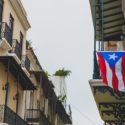One argument against statehood for Puerto Rico that we often hear is that we have to wait for better times. History shows us that this its not true. Kansas Territory was known as “Bleeding Kansas” when it became a state. Minnesota was in a financial emergency and nearly declared independence. New Mexico had 50 admission bills as they worked toward statehood. Florida was at war when they started petitioning for statehood.
In short, there are no rules saying that a territory has to be prosperous and comfortable before it can become a state.
A new article by Raul Maldonado takes a new angle on this popular misconception.
“Once we stop the economic contraction and stabilize the economy, through a reduction in the wealth inequality gap and a measurable substantial improvement in the education of our youth,” he says, “then we are ready to decide our future, statehood or sovereignty.”
Maldonado declares himself a statehood supporter. “I am a statesman because I think it is the best option for the welfare of our most vulnerable population,” he explains. He points out the impractical nature of independence as a status for Puerto Rico. He does so on economic grounds, not philosophical ones.
But he also says that “sovereignty” is a practical choice. “Once we stop the economic contraction and stabilize the economy, through a reduction in the wealth inequality gap and a measurable substantial improvement in the education of our youth,” he says, “then we are ready to decide our future, statehood or sovereignty.”
The same path?
“Both for those of us who believe in statehood and for sovereignty, we need to improve the quality of life of the people,” says Maldonado. “The road is the same.”
It really isn’t.
As a state, Puerto Rico will have a level playing field with the 50 current states. Now, as a territory, Puerto Rico gets less federal funding, less in federal healthcare spending, fewer tax credits, less in support for the poor, and fewer federal contracts. History also shows that territories, when they become states, get more investment — fast.
In Hawaii, both U.S. and foreign firms rushed to invest in the new state. According to the Economic History Association, “The transition from territorial to statehood status was one factor behind the 1958-1973 boom, in which real per capita personal income increased at an annual rate of 4 percent.”
Every territory found greater prosperity following statehood. Puerto Rico will be the same. So a plan for economic stability and development for the state of Puerto Rico will be different from the plan for a territory.
Sovereignty?
The Supreme Court recently declared that Puerto Rico is not sovereign. Puerto Rico is a territory of the United States. That’s all.
But there has been a political movement toward sovereigntism in Puerto Rico. As recently as 2010, a document was produced that laid out a possible agreement under which Puerto Rico would not be a territory of the United States, but would have “a dignified and democratic relationship between two Nations who are different in their origins, but who are united by political and legal bonds, as well as a history of friendship and collaboration.”
This document called for sovereignty and self-government, free of the Territorial Clause in the United States Constitution, which currently governs Puerto Rico. It dissolves the relationship between Puerto Rico and the United States based on the Treaty of Paris. It declares Puerto Rico free of all U.S. laws. All U.S. property becomes the property of Puerto Rico. Puerto Rico has full rights to conduct foreign affairs and trade. In other words, Puerto Rico will be an independent nation.
It gives birthright U.S. citizenship and Puerto Rican citizenship to everyone “of Puerto Rican descent.” People can still move freely from Puerto Rico to the United States, work in the U.S., and hold U.S. passports as well as Puerto Rico passports. The United States will continue to support Puerto Rico financially for at least 30 years, and will continue all services and programs it was providing to the territory. Social Security, Medicare, and so forth are specifically mentioned, but the U.S. will not collect any taxes from Puerto Rico. The territory’s debts will be cancelled. In other words, Puerto Rico will continue to be dependent on the United States.
At this point — and, in fact, throughout the ten years of this document’s existence — no member of the federal government has been willing to discuss this option. This is the “Fantasy Island” system which the United States has repeatedly rejected.
So what would a plan for economic development under this imaginary status look like? We have 32 territories which have become states, whose history we can look at. But there is no independent nation with dual U.S. citizenship and one-sided economic support from the United States. We can’t use history to envision an economic development plan for the fantasy. And there is really no point in trying to come up with a path to a fantasy.
Maldonado proposes that Puerto Rico improve its educational system, reduce the wealth gap among its residents, and stabilize its economy. These are all good goals. They will be easier to accomplish under statehood than they are now, when Puerto Rico is a territory. Tell your congressional reps that it is time for statehood.








No responses yet